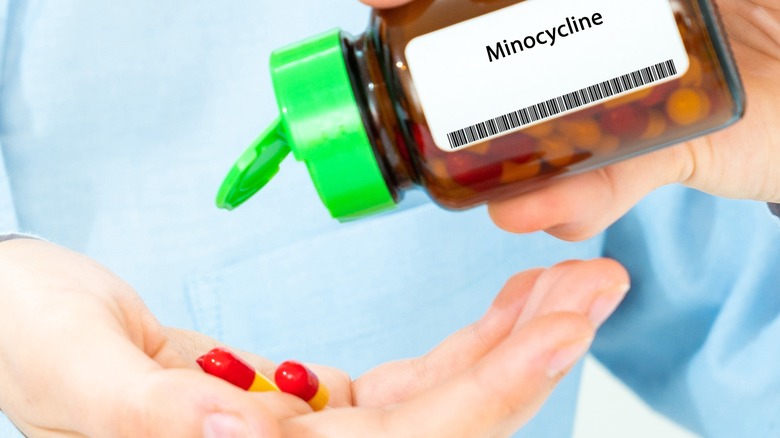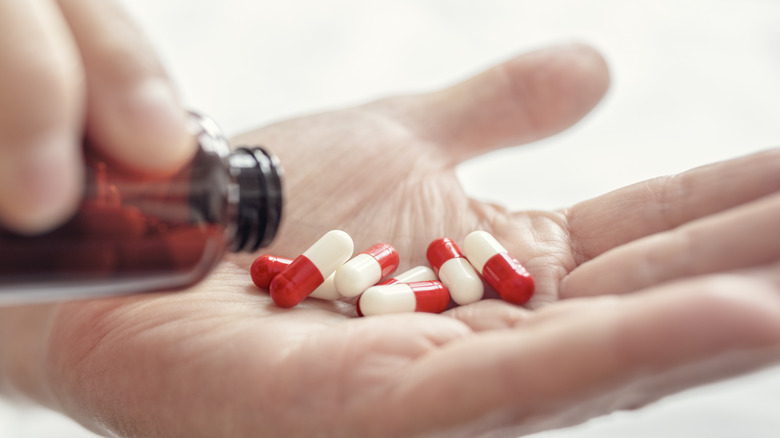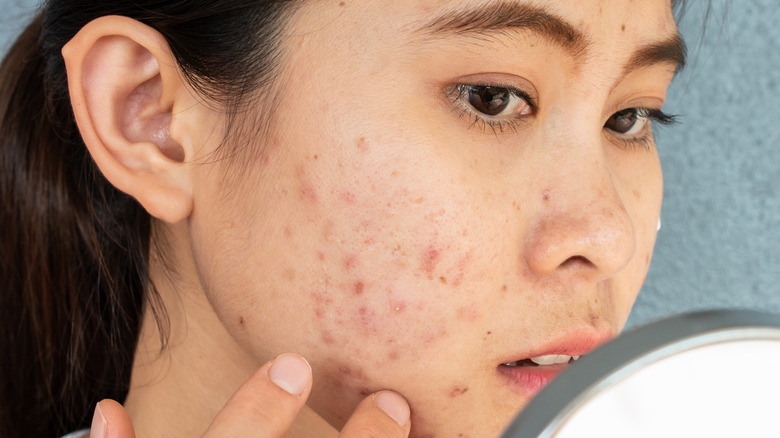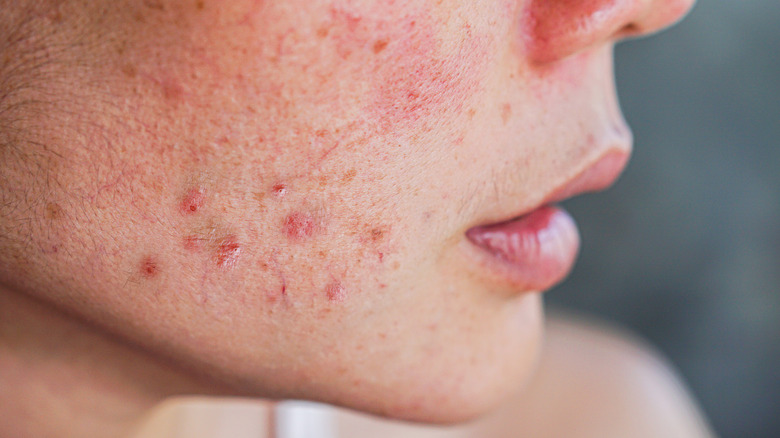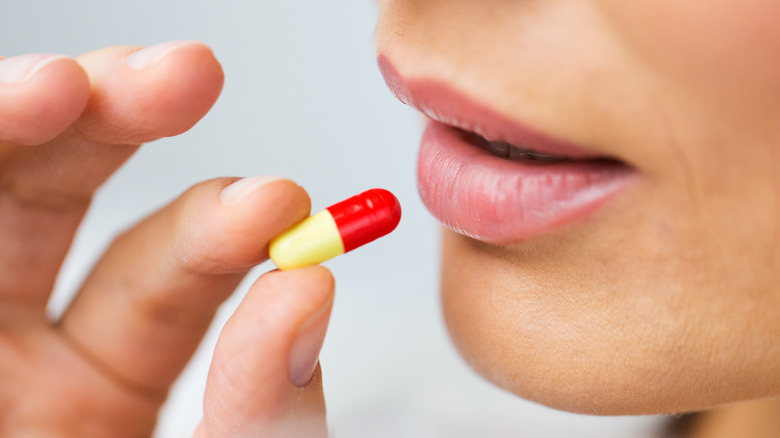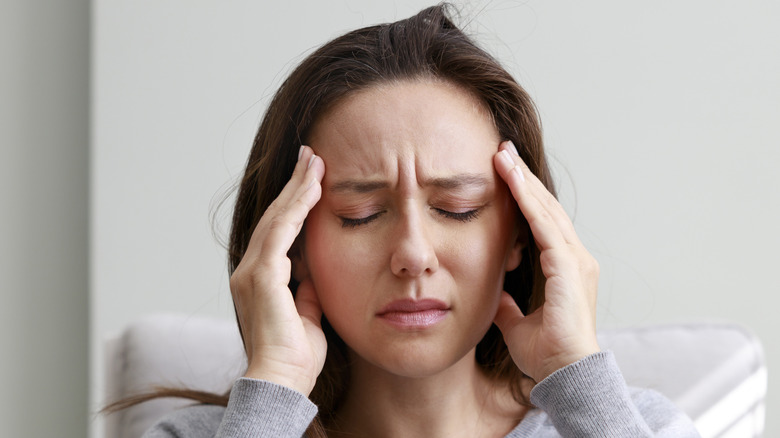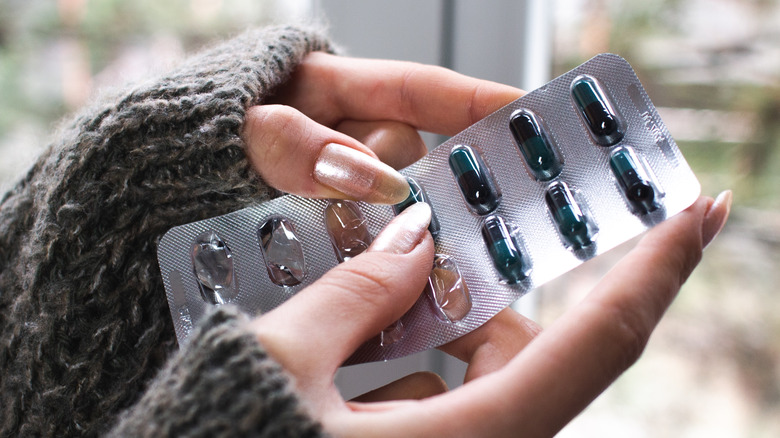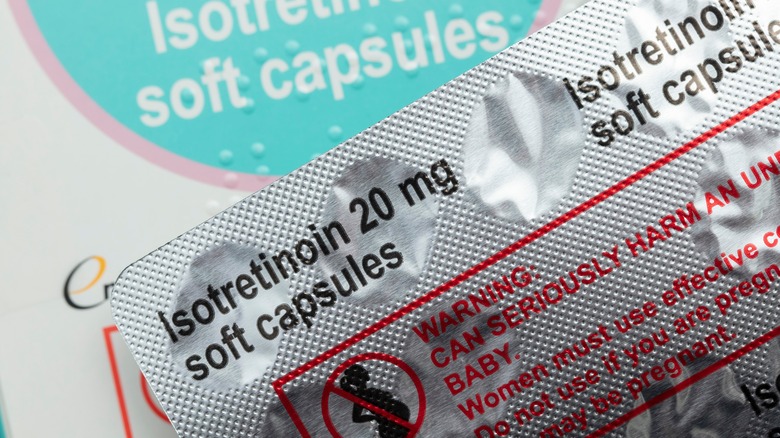Enter Minocycline, The Antibiotic That Claims To Zap Zits
Acne affects over 45 million people in the United States and is often a common problem for teenagers. While the condition improves with age for some people, for others, it can turn into a more persistent issue. Thankfully, there is a range of treatments that can treat acne, including topical treatments, azelaic acid, and in more extreme cases, antibiotics. Some people find certain treatments work better than others; however, it usually depends on the individual taking them.
Those with more severe acne are often prescribed a course of antibiotics alongside another complementary treatment so that patients can achieve maximum results. Several treatment options are available, including an antibiotic known as minocycline. This treatment is occasionally prescribed by doctors and is a well-known option that can help to solve skin issues concerning acne. Below, we'll take a deep dive into what this antibiotic is really all about. So, what is minocycline?
What is minocycline?
If you suffer from moderate to severe acne, you may have heard your doctor discussing antibiotics before. More specifically, they may have introduced minocycline to you — a popular antibiotic doctors use to treat more severe cases of acne. While its usage isn't as common, doctors may still discuss it as an option. So, what is it?
Minocycline is used to treat bacterial and inflammatory acne and is available in topical, oral, capsule, and injection forms. In its topical form, it is used as a foam and applied to the skin per your doctor's instructions. The oral form of the antibiotic can be taken like any other pill, again, per your doctor's instructions. How much and which form of the antibiotic you take will largely depend on several factors, such as the severity of your acne, its location, and your body weight.
However, minocycline doesn't treat all types of acne. Instead, it is specifically used to treat those due to acne vulgaris — a type of acne that sees hair follicles and their sebaceous gland become blocked, via Medscape.
It works by targeting acne-causing bacteria
As mentioned earlier, acne vulgaris is caused by the blocking of the sebaceous gland. The hair follicles become clogged by a build-up of oil, bacteria, and dead skin cells. This process often results in painful, cystic-type acne. Like most antibiotics, minocycline works by targeting bacteria. So, in this case, acne-causing bacteria. More specifically, minocycline works by controlling "the concentration of bacteria around sweat glands and hair follicles on acne prone skin," board-certified dermatologist Dr. Greenfield tells Marie Claire.
This means that the growth and any potential spread of the bacteria are severely inhibited, thus making it challenging for acne to form in the same way as before. As a result, any cysts, pustules, and painful spots should be significantly reduced as fewer acne-causing bacteria are produced. In addition, this effect may also help to dampen any redness on your skin. This bacteria-blasting treatment works similarly to other antibiotic treatments for acne, and each remedy usually targets acne-producing bacteria in some form, which makes it quite effective. Of course, this is great news for your skin if you suffer from this specific type of acne.
It may not treat other acne triggers
While minocycline is great for acne triggered by bacteria, it's not as effective when treating other causes of the problem. Board-certified dermatologist and founder of Niche Dermatology Dr. Marchbein explains that acne can also be caused by "hyperkeratinization of the follicle, overactive oil gland, hormone production, and inflammation," thus making it harder for minocycline to treat these specific causes, via Marie Claire. So, if more than one trigger is causing your acne, you may need to combine treatments to get the best results. However, your doctor will likely advise the best treatment options for your skin.
In addition to not being effective at treating other acne triggers, minocycline doesn't work for getting rid of scarring either. Scarring is usually the result of damaged skin, either from picking at your skin or bursting spots. For many, scarring due to acne can be incredibly frustrating; however, it can be improved with microneedling. Thankfully, it's easily treatable via the use of other remedies.
How long does minocycline take to work?
When we take any treatment, we expect it to get to work quickly. However, it's not always the case. If you're taking minocycline and haven't noticed a big difference in your acne, there may be a good reason. If you've been taking it for a few weeks, it is likely because you haven't waited long enough for it to take effect fully. So, how long does minocycline take to work?
According to Healthline, minocycline can take anywhere from six to eight weeks to take full effect. Before that, you may not see a notable difference in your skin. However, some people can notice a difference much sooner than this timeframe, at around the two-week mark. This will vary from individual to individual and shouldn't be a cause for concern. While it can be frustrating, it is always best to be patient and wait for the treatment to take effect.
What you can expect when taking minocycline
While minocycline is generally effective at treating severe acne, it also comes with its downsides. For some people, these downsides may seem quite severe. Like with any medicine, you may experience side effects, with some of the most common including peeling or blistering of the skin, headaches, vertigo, nausea, diarrhea, and yeast infections, among many others. You may even see some discoloration of the skin. Doctors consider this antibiotic to have many side effects compared to other treatments, so they are usually hesitant to prescribe it.
You should also be aware that just like any other antibiotic, minocycline will kill both good and bad bacteria in your body. Talking to Marie Claire, Dr. Marchbein explains that minocycline "can completely destroy your gut microbiome and flora, as well as disrupt the skin's microbiome," which may put you at more risk for developing gut-related issues later down the line. However, this is just one of the problems associated with minocycline. You can also potentially put yourself at risk for antibiotic resistance due to taking the treatment, so your body may find it harder to fight off future infections. Additionally, you may put yourself at heightened risk for auto-immune issues.
It's not recommended as a first choice for treating acne
Minocycline is considered quite an extreme treatment by doctors and is usually only considered a last resort. Instead, it is recommended to first try medicines with better safety profiles, such as doxycycline, oxytetracycline, or lymecycline, via British Medical Journal. This is recommended because they are generally considered safer than minocycline with fewer side effects, making them better suited for most patients.
Dr. Marchbein highlights the same sentiment. He explains: "It's one of my least favorite oral antibiotics and I never prescribe it" (via Marie Claire). Instead, he recommends alternative antibiotic treatments such as doxycycline or seysara, which are usually better tolerated by patients taking them.
Due to its extreme nature and a long list of side effects, minocycline is generally only prescribed for a short time and should be used for no longer than 12 weeks, per Medical News Today. All of these contributing factors ultimately influence whether a doctor prescribes this antibiotic. While effective, it is not preferred or recommended as a first treatment choice.
What should you avoid when taking minocycline?
If you begin taking minocycline for your acne, you should know what to avoid. Mixing certain products and medications may result in the treatment not working as it should, as it can affect how the body absorbs it. When taking minocycline, you should avoid consuming any product that contains calcium, magnesium, zinc, iron, antacids, multivitamins, and laxatives, via WebMD. You should also wait two hours at the very least before taking your treatment if you have consumed any of these.
As a general rule, you should also avoid medications such as blood thinners, birth control pills, penicillin treatments, and acne drugs with isotretinoin (via Medical News Today). All of these treatments can potentially react with minocycline and, again, potentially alter how it impacts you.
Considering this, it is always best to consult with your doctor if you are taking any other medications or substances that you suspect could affect how the treatment works. Logically, you want to give your antibiotics the best chance of eliminating that acne once and for all — and that goes for all of them.
